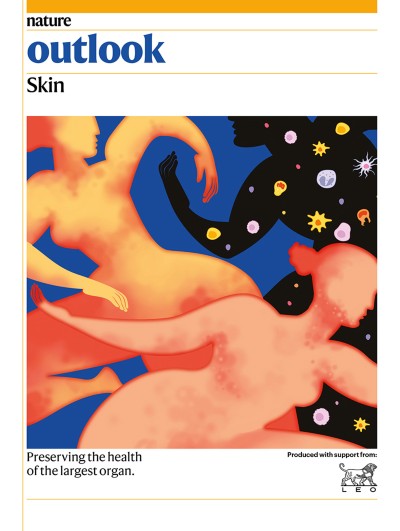You have full access to this article via your institution.
Dermatology is a profoundly visual specialty. Diagnoses are rooted in the observation of hue and pattern. Yet, despite our reliance on these visual cues, dermatologists lack the ability — and vocabulary — to meaningfully characterize one of the most defining human features: skin colour. Instead, we have relied on proxies such as race, ethnicity and a crude skin-classification scheme. These frameworks are deeply entrenched and seriously flawed. They flatten nuance, obscure true contributors to disease and ultimately compromise the provision of care.
Race and ethnicity are social constructs, not rooted in biological fact. Yet these categories are routinely included in clinical trials and embedded in care guidelines. This leads to misinterpretation of data and failure to identify the factors that contribute to disease — not only in dermatology, but also in other fields. Race-based corrections in algorithms that estimate kidney health, for example, lead to the systematic overestimation of kidney function in Black people, delaying referrals and reducing transplant eligibility1.
Nature Outlook: Skin
In dermatology, the issue is more insidious. Skin colour, which is often perceived as the physical embodiment of race, is conflated with race itself — even though pigmentation varies widely in racial categories. These ideas can influence clinical decisions. One study found that medical trainees who endorsed false beliefs about biological differences between racial groups were more likely to underestimate pain in Black people than in white people, leading to inadequate pain management for Black patients2.
The Fitzpatrick skin type (FST) scale — often described as the gold standard for skin classification — was never designed to measure pigmentation. Developed to estimate ultraviolet light sensitivity in white people with psoriasis, it has evolved into a proxy for skin colour in research and clinical care. Its broad appeal lies in its simplicity and familiarity; FST is based on a person’s assessment of whether their skin burns or tans after exposure to sunlight. However, studies have repeatedly shown that it is flawed: it has poor inter-rater reliability, narrow purpose and fails to adequately represent the spectrum of darker skin tones3. In practice, it is frequently misapplied as a surrogate not only for pigmentation, but also for race and ethnicity.
The Monk skin-tone scale attempts to address these gaps by offering an expanded range of skin tones and decoupling skin colour from photosensitivity4. It nevertheless falls short because it remains tethered to narrow colour references and lacks clinical utility. It’s a start, but not a solution.
We know that the degree of pigmentation in a person’s skin is clinically relevant: it influences the risk of skin cancer, vitamin-D deficiency and pigmentation disorders. It also affects diagnostic accuracy owing to variations in clinical presentation across different skin tones. But we lack the language to describe skin colour with the precision it demands. In research and practice, we resort to vague descriptors such as ‘light’ or ‘dark’ that mean little at the bench or the bedside. This terminology gap weakens the reproducibility of research and impairs personalized treatment.
As artificial intelligence and machine learning enter the clinic, the stakes become even higher. When the data sets that inform these technologies are not representative, we risk embedding bias into the tools that are meant to equalize the playing field because many data sets are overwhelmingly skewed towards lighter skin types5.
Dermatologists understand the shortcomings of the status quo, and the urgency of reform. We are therefore uniquely positioned to lead the change. But moving forward will require more than critique — it demands collective efforts to develop skin-classification tools that provide scientific rigour, and the courage to critically reassess the use of race in dermatological research and practice.
More from Nature Outlooks
This transformation will need time, sustained funding and collaboration across multiple sectors. If academic institutions and professional societies join together to develop classification systems, it would provide a rigorous foundation for their use. Regulatory agencies would need to establish guidelines for their implementation and ensure consistent application across studies. Scientific journals would need to promote accurate and transparent reporting of race and skin tone. Partnerships with community groups would be crucial to support ongoing outreach efforts and build public trust and understanding around these initiatives.
What should replace the current patchwork system? Imagine a non-hierarchical pigmentation classification system that is free from racial cues and grounded in objective measurement, perhaps using technologies such as reflectance spectrometry. Such a system would be rigorously validated across populations and designed to predict clinically meaningful outcomes, such as the likelihood of post-inflammatory hyperpigmentation, risk of skin cancer and pattern of therapeutic response. It could have a simplified clinical form and a more detailed research version. Importantly, it would reflect biology, not social identity.
Continuing to rely on imprecise, outdated constructs undermines the very core of our field. Getting skin colour right is not just an academic exercise — it is a scientific and clinical imperative. Cutaneous pigmentation is measurable, it is biologically relevant and it is much too important to be left to guesswork.
Competing Interests
V.H. serves as a consultant for AbbVie, Bristol Myers Squibb, Janssen, Johnson & Johnson, and L’Oréal, Cerave receiving honoraria; and serves as an advisory board member for SkinCeuticals, receiving honoraria.




